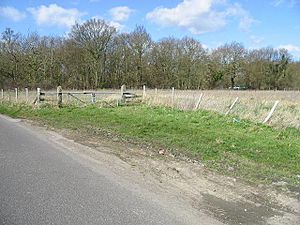East Blean Woods facts for kids
| Site of Special Scientific Interest | |
 |
|
| Area of Search | Kent |
|---|---|
| Interest | Biological |
| Area | 151.4 hectares (374 acres) |
| Notification | 1985 |
| Location map | Magic Map |
East Blean Woods is a very special natural area in Kent, England. It covers about 151.4-hectare (374-acre), which is like 374 football fields! This amazing place is south of Herne Bay and is protected for its unique plants and animals.
It's known as a Site of Special Scientific Interest (SSSI) because of its important wildlife. It's also a National Nature Reserve and a Special Area of Conservation. This means it's one of the best places in the country for nature. The Kent Wildlife Trust helps look after a big part of these woods.
Contents
Discover East Blean Woods
East Blean Woods is an ancient woodland, meaning it has been a forest for hundreds of years. It sits on a type of soil called London clay. This clay doesn't let water drain away easily, so the woods can be very muddy in winter and even during wet summers.
The Soil and Its Plants
The soil here is mostly a bit acidic. This is why you'll see huge carpets of beautiful bluebells in spring. You might also spot patches of heather.
However, some parts of the woods have more alkaline soil. In these areas, you can find different plants. Look out for spurge-laurel, sanicle, and the pretty common spotted orchid. Each plant likes a specific type of soil!
A Home for Rare Butterflies
For a long time, people have managed these woods. They used to let animals graze here, which is called wood pasture. They also cut sweet chestnut trees in a special way called coppiceing. Coppicing means cutting trees close to the ground so new shoots grow back. This helps keep the woodland healthy.
The Heath Fritillary Butterfly
When the coppice is cut, more sunlight reaches the ground. This helps a plant called common cow-wheat to grow. This plant is super important because it's the main food for the caterpillars of the rare heath fritillary butterfly. This butterfly is one of Britain's rarest!
As the chestnut trees grow back, the woods become shadier. This makes it harder for the common cow-wheat and the butterflies to thrive. That's why it's so important to keep coppicing regularly. It creates open, sunny spots that the heath fritillary needs to survive.
Other Wildlife in the Woods
Even the older, shadier parts of the woods are important. They provide great places for birds like warblers to build their nests. The older oak trees and wild service trees also attract many insects. These insects then become food for other birds, such as woodpeckers, nuthatches, and treecreepers. East Blean Woods is truly a busy and lively place for all sorts of creatures!

